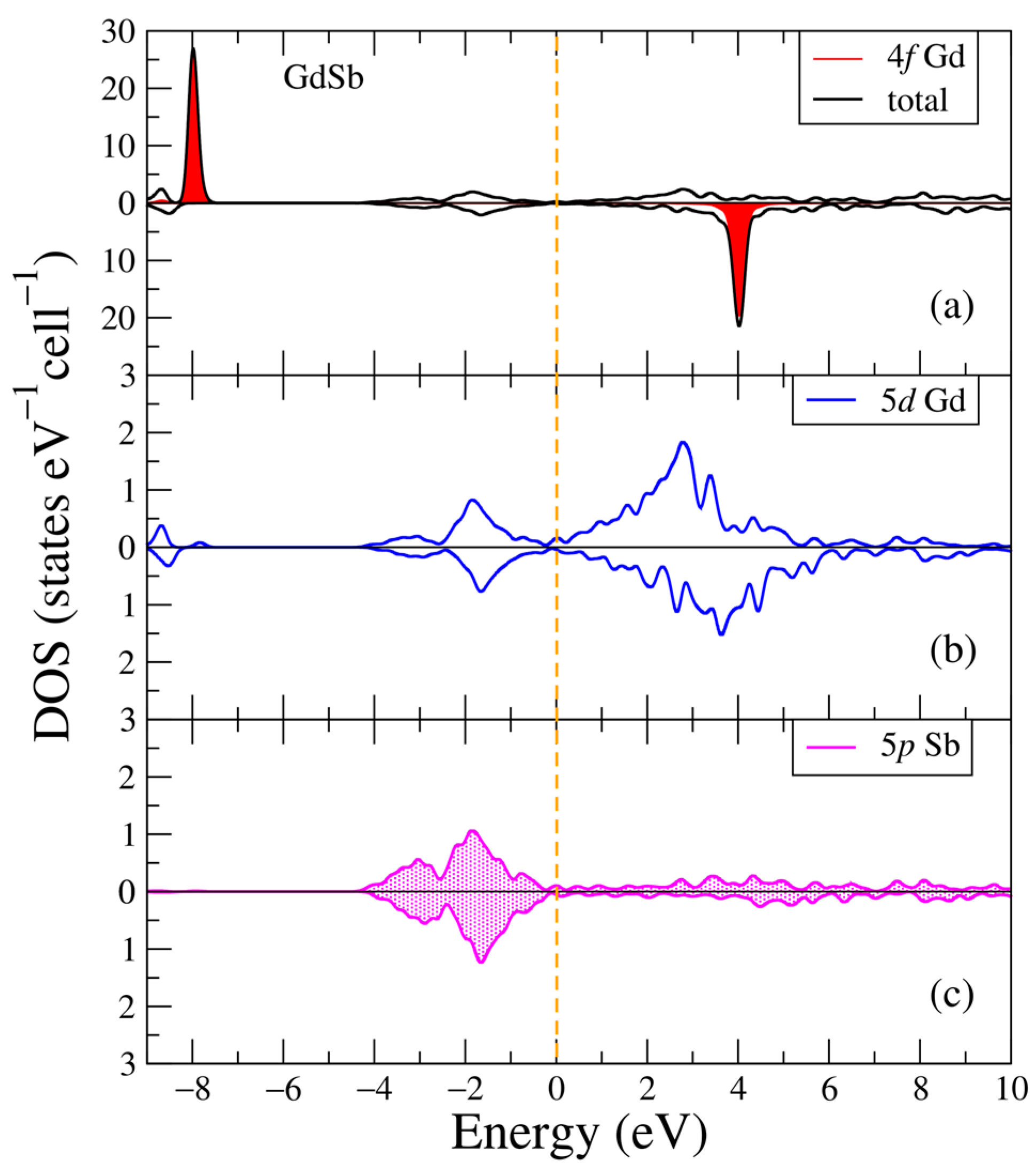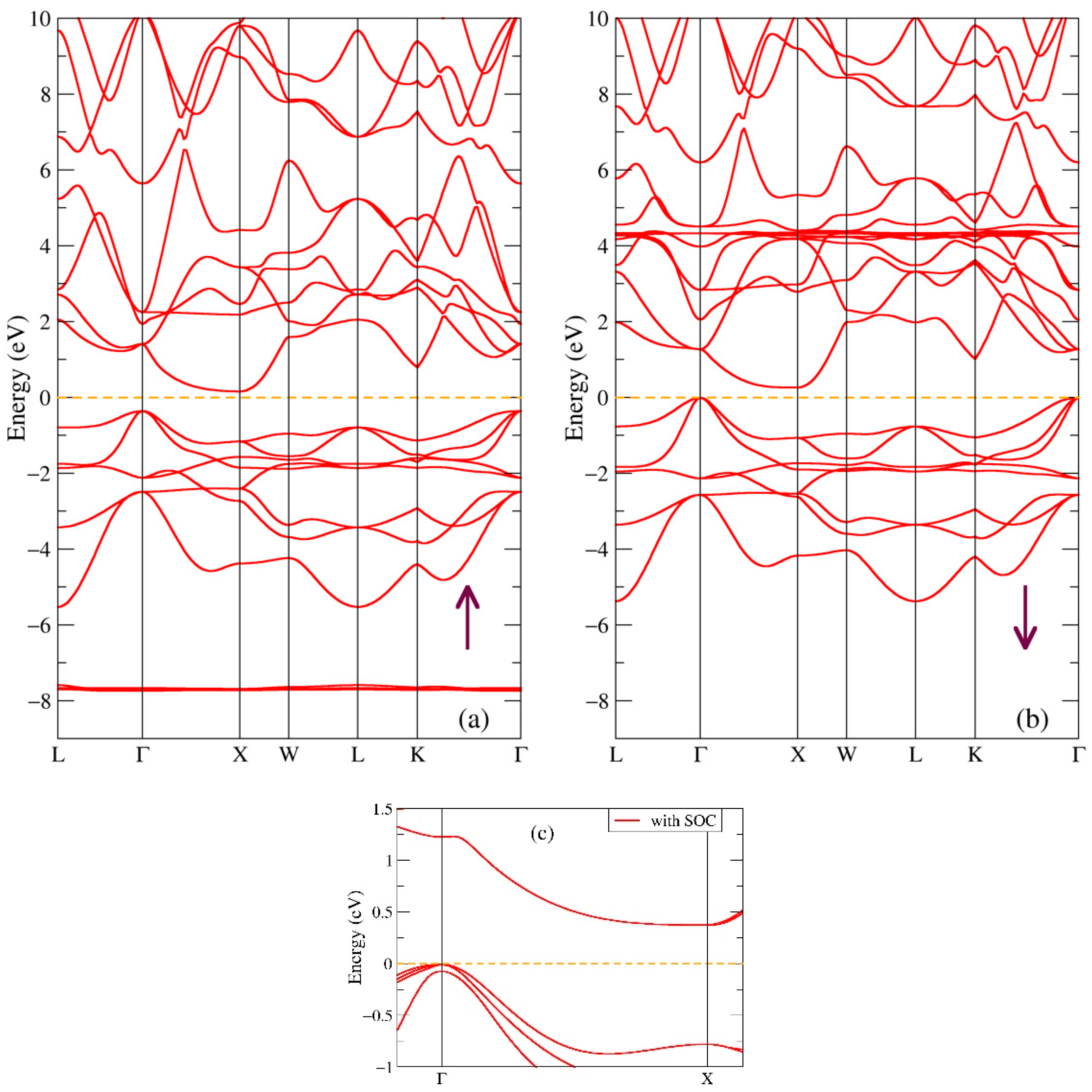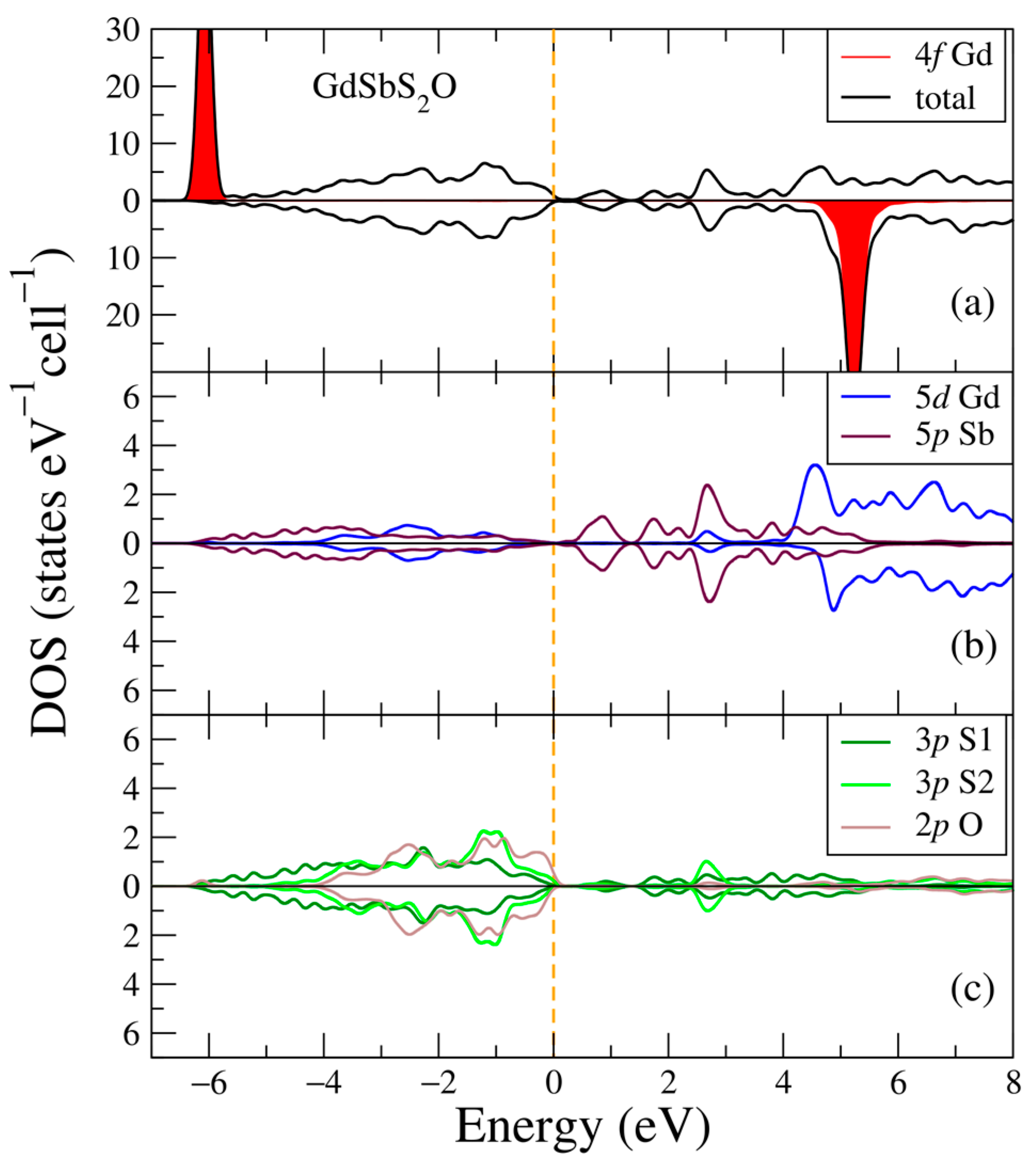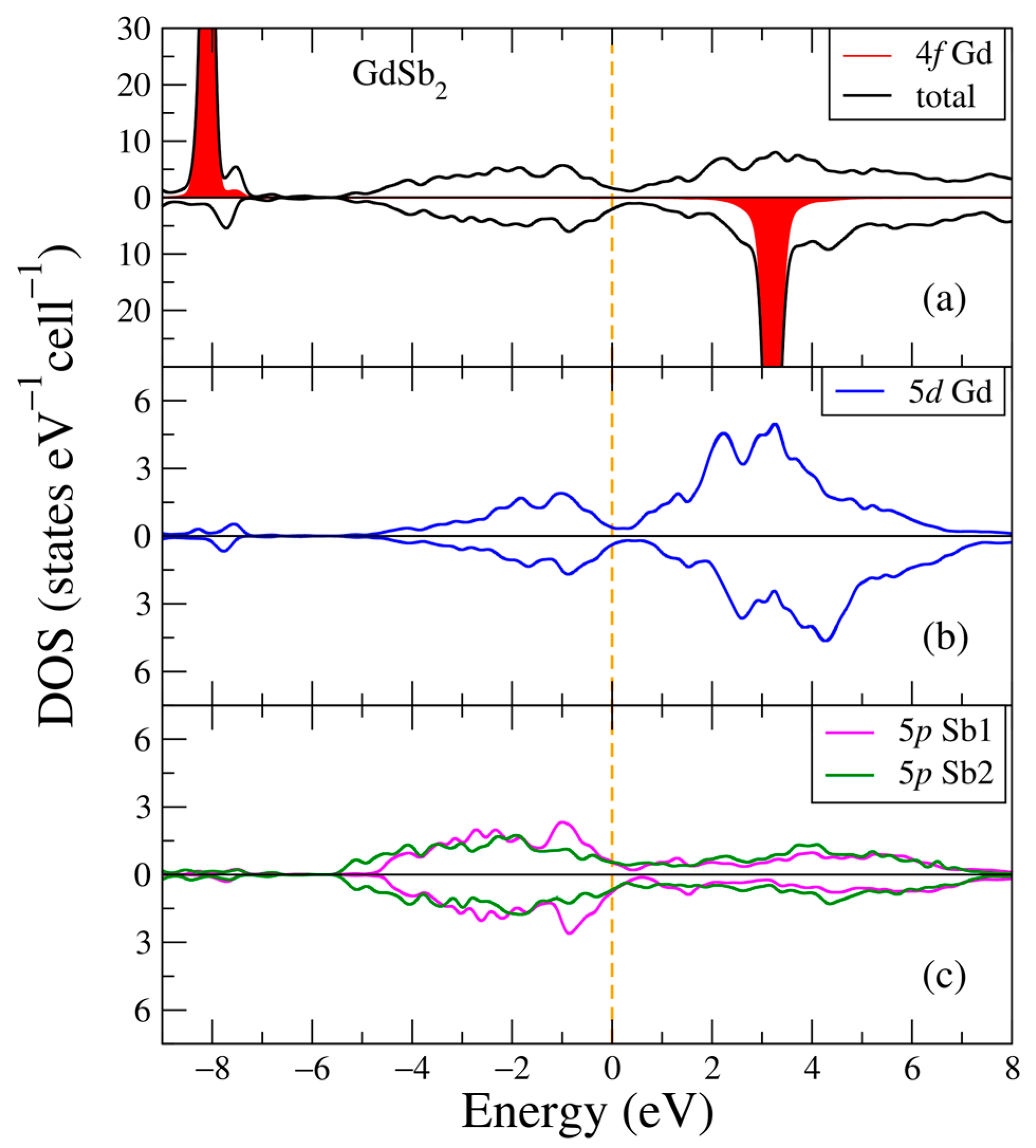Semimetallic, Half-Metallic, Semiconducting, and Metallic States in Gd-Sb Compounds
Abstract
1. Introduction
2. Results and Discussion
2.1. GdSb Compound
2.2. GdNiSb Compound
2.3. Gd4Sb3 Compound
2.4. GdSbS2O Compound
2.5. GdSb2 Compound
3. Materials and Methods
4. Conclusions
Author Contributions
Funding
Institutional Review Board Statement
Informed Consent Statement
Data Availability Statement
Conflicts of Interest
References
- Keimer, B.; Moore, J.E. The physics of quantum materials. Nat. Phys. 2017, 13, 1045–1055. [Google Scholar] [CrossRef]
- Hasan, M.Z.; Kane, C.L. Colloquium: Topological insulators. Rev. Mod. Phys. 2010, 82, 3045–3067. [Google Scholar] [CrossRef]
- He, K.; Wang, Y.; Xue, Q.-K. Topological materials: Quantum anomalous Hall system. Annu. Rev. Condens. Matter Phys. 2018, 9, 329–344. [Google Scholar] [CrossRef]
- Franz, M.; Rozali, M. Mimicking black hole event horizons in atomic and solid-state systems. Nat. Rev. Mater. 2018, 3, 491–501. [Google Scholar] [CrossRef]
- Hasan, M.Z.; Xu, S.-Y.; Bian, G. Topological insulators, topological superconductors and Weyl fermion semimetals: Discoveries, perspectives and outlooks. Phys. Scr. 2015, 2015, 014001. [Google Scholar] [CrossRef]
- Huan, S.; Zhang, S.; Jiang, Z.; Su, H.; Wang, H.; Zhang, X.; Yang, Y.; Liu, Z.; Wang, X.; Yu, N.; et al. Multiple Magnetic Topological Phases in Bulk van der Waals Crystal MnSb4Te7. Phys. Rev. Lett. 2021, 126, 246601. [Google Scholar] [CrossRef]
- Kim, M.; McNally, G.M.; Kim, H.H.; Oudah, M.; Gibbs, A.S.; Manuel, P.; Green, R.J.; Sutarto, R.; Takayama, T.; Yaresko, A.; et al. Superconductivity in (Ba,K)SbO3. Nat. Mater. 2022, 21, 627–633. [Google Scholar] [CrossRef]
- Pan, Y.; Fan, F.R.; Hong, X.; He, B.; Le, C.; Schnelle, W.; He, Y.; Imasato, K.; Borrmann, H.; Hess, C.; et al. Thermoelectric Properties of Novel Semimetals: A Case Study of YbMnSb2. Adv. Mater. 2021, 33, 2003168. [Google Scholar] [CrossRef]
- Wu, Y.; Kong, T.; Wang, L.-L.; Johnson, D.D.; Mou, D.; Huang, L.; Schrunk, B.; Bud’ko, S.L.; Canfield, P.C.; Kaminski, A. Asymmetric mass acquisition in LaBi: Topological semimetal candidate. Phys. Rev. B 2016, 94, 081108. [Google Scholar] [CrossRef]
- Niu, X.H.; Xu, D.F.; Bai, Y.H.; Song, Q.; Shen, X.P.; Xie, B.P.; Sun, Z.; Huang, Y.B.; Peets, D.C.; Feng, D.L. Presence of exotic electronic surface states in LaBi and LaSb. Phys. Rev. B 2016, 94, 165163. [Google Scholar] [CrossRef]
- Nayak, J.; Wu, S.-C.; Kumar, N.; Shekhar, C.; Singh, S.; Fink, J.; Rienks, E.E.D.; Fecher, G.H.; Parkin, S.S.P.; Yan, B.; et al. Multiple Dirac cones at the surface of the topological metal LaBi. Nat. Commun. 2017, 8, 13942. [Google Scholar] [CrossRef]
- Oinuma, H. Three-dimensional band structure of LaSb and CeSb: Absence of band inversion. Phys. Rev. B 2017, 96, 041120. [Google Scholar] [CrossRef]
- Pavlosiuk, O. Magnetoresistance in LuBi and YBi semimetals due to nearly perfect carrier compensation. Phys. Rev. B 2018, 97, 235132. [Google Scholar] [CrossRef]
- Lou, R. Evidence of topological insulator state in the semimetal LaBi. Phys. Rev. B 2017, 95, 115140. [Google Scholar] [CrossRef]
- Wu, Y.; Lee, Y.; Kong, T.; Mou, D.; Jiang, R.; Huang, L.; Bud’ko, S.L.; Canfield, P.C.; Kaminski, A. Electronic structure of RSb (R = Y, Ce, Gd, Dy, Ho, Tm, Lu) studied by angle-resolved photoemission spectroscopy. Phys. Rev. B 2017, 96, 035134. [Google Scholar] [CrossRef]
- Li, Z.; Xu, D.-D.; Ning, S.-Y.; Su, H.; Iitaka, T.; Tohyama, T.; Zhang, J.-X. Predicted Weyl fermions in magnetic GdBi and GdSb. Int. J. Mod. Phys. B 2017, 31, 1750217. [Google Scholar] [CrossRef]
- Li, D.X.; Haga, Y.; Shida, H.; Suzuki, T. Electrical transport properties of semimetallic GdX single crystals (X = P, As, Sb, and Bi). Phys. Rev. B 1996, 54, 10483–10491. [Google Scholar] [CrossRef]
- Knyazev, Y.V.; Kuz’min, Y.I.; Baidak, S.T.; Lukoyanov, A.V. Investigation of semimetallic properties of GdSb and TbSb compounds: A first-principle and optical study. Solid State Sci. 2023, 136, 107085. [Google Scholar] [CrossRef]
- Niu, R. Materials and possible mechanisms of extremely large magnetoresistance: A review. J. Phys. Condens. Matter 2021, 34, 113001. [Google Scholar] [CrossRef]
- Pavlosiuk, O.; Kleinert, M.; Swatek, P.; Kaczorowski, D.; Wiśniewski, P. Fermi surface topology and magnetotransport in semimetallic LuSb. Sci. Rep. 2017, 7, 12822. [Google Scholar] [CrossRef]
- Volkov, M.P. Magnetization and giant magnetoresistance of polycrystalline TbSb at low temperatures. Phys. Solid State 2019, 61, 1416–1419. [Google Scholar] [CrossRef]
- Wang, Y.-Y.; Sun, L.-L.; Xu, S.; Su, Y.; Xia, T.-L. Unusual magnetotransport in holmium monoantimonide. Phys. Rev. B 2018, 98, 045137. [Google Scholar] [CrossRef]
- Xia, Z.-L.; Tang, F.; Xu, C.-Q.; Cong, S.; Zhao, W.; Zhang, L.; Han, Z.-D.; Qian, B.; Jiang, X.-F.; Ke, X.; et al. Influence of magnetization anisotropy on angular magnetoresistance in the antiferromagnetic topological semimetal HoSb. Phys. Rev. B 2022, 106, 115137. [Google Scholar] [CrossRef]
- Kuchin, A.G.; Platonov, S.P.; Mukhachev, R.D.; Lukoyanov, A.V.; Volegov, A.S.; Gaviko, V.S.; Yakovleva, M.Y. Large magnetic entropy change in GdRuSi optimal for magnetocaloric liquefaction of nitrogen. Metals 2023, 13, 290. [Google Scholar] [CrossRef]
- Gupta, S.; Lukoyanov, A.V.; Knyazev, Y.V.; Kuz’min, Y.I.; Suresh, K.G. Field induced metamagnetism and large magnetic entropy change in RRhSi (R = Tb, Dy, Ho) rare earth intermetallics. J. Alloys Compd. 2021, 888, 161493. [Google Scholar] [CrossRef]
- Gupta, S.; Suresh, K.G.; Nigam, A.K.; Lukoyanov, A.V. Magnetism in RRhGe (R = Tb, Dy, Er, Tm): An experimental and theoretical study. J. Alloys Compd. 2015, 640, 56–63. [Google Scholar] [CrossRef]
- Hosen, M.M.; Dhakal, G.; Dimitri, K.; Maldonado, P.; Aperis, A.; Kabir, F.; Sims, C.; Riseborough, P.; Oppeneer, P.M.; Kaczorowski, D.; et al. Discovery of topological nodal-line fermionic phase in a magnetic material GdSbTe. Sci. Rep. 2018, 8, 13283. [Google Scholar] [CrossRef]
- Sankar, R. Crystal Growth and Magnetic Properties of Topological Nodal-Line Semimetal GdSbTe with Antiferromagnetic Spin Ordering. Inorg. Chem. 2019, 58, 11730–11737. [Google Scholar] [CrossRef]
- Wei, X.-P.; Hu, X.-R.; Dai, Y.-C.; Lei, T.; Chu, S.-B.; Deng, J.-B. Electronic Structure of Ternary Antimonides GdNiSb. Acta Phys. Pol. A 2011, 119, 405–407. [Google Scholar] [CrossRef]
- Sahariya, J.; Kumar, P.; Bhamu, K.C.; Soni, A. Electronic structure of Gd based transition metal antimonides GdTSb (T = Ni, Pt). AIP Conf. Proc. 2018, 1953, 110010. [Google Scholar] [CrossRef]
- Hirschberger, M.; Kushwaha, S.; Wang, Z.; Gibson, Q.; Liang, S.; Belvin, C.A.; Bernevig, B.A.; Cava, R.J.; Ong, N.P. The chiral anomaly and thermopower of Weyl fermions in the half-Heusler GdPtBi. Nat. Mater. 2016, 15, 1161–1165. [Google Scholar] [CrossRef]
- Shekhar, C. Anomalous Hall effect in Weyl semimetal half-Heusler compounds RPtBi (R = Gd and Nd). Proc. Natl. Acad. Sci. USA 2018, 115, 9140–9144. [Google Scholar] [CrossRef]
- Hartjes, K.; Jeitschko, W. Crystal structures and magnetic properties of the lanthanoid nickel antimonides LnNiSb (Ln = La–Nd, Sm, Gd–Tm, Lu). J. Alloys Compd. 1995, 226, 81–86. [Google Scholar] [CrossRef]
- Baidak, S.T.; Lukoyanov, A.V. Common topological features in band structure of RNiSb and RSb compounds for R = Tb, Dy, Ho. Materials 2023, 16, 242. [Google Scholar] [CrossRef]
- Saini, S.M. Electronic Structure and Thermoelectric Performance of Narrow-Gap GdNiSb Half Heusler Compound: Density Functional Calculations. Phys. Status Solidi B 2021, 258, 2000491. [Google Scholar] [CrossRef]
- Ciesielski, K.; Synoradzki, K.; Veremchuk, I.; Skokowski, P.; Szymański, D.; Grin, Y.; Kaczorowski, D. Thermoelectric Performance of the Half-Heusler Phases RNiSb (R = Sc, Dy, Er, Tm, Lu): High Mobility Ratio between Majority and Minority Charge Carriers. Phys. Rev. Appl. 2020, 14, 054046. [Google Scholar] [CrossRef]
- Satyam, J.K.; Saini, S.M. Role of R-f states on electronic structure and thermoelectric performance of RNiSb (R = Gd, Er and Lu) half Heusler compounds: Narrow gap thermoelectric materials. Appl. Phys. A 2021, 127, 828. [Google Scholar] [CrossRef]
- Lukoyanov, A.V.; Baidak, S.T. Ab initio investigation of electronic structure and topological features in ErNiSb and ErSb compounds. IOP Conf. Ser. Mater. Sci. Eng. 2022, 1263, 012026. [Google Scholar] [CrossRef]
- Eatough, N.L.; Hall, H.T. High-pressure synthesis of rare earth diantimonides. Inorg. Chem. 1969, 8, 1439–1445. [Google Scholar] [CrossRef]
- Abdusalyamova, M.N.; Burnashev, O.R.; Mironov, K.Y. The alloy systems ln-Sb. J. Less-Common Met. 1986, 125, 1–6. [Google Scholar] [CrossRef]
- Aliev, O.M.; Tanryverdiev, V.S. Rare-Earth Oxysulfostibnites: Synthesis and Some Physical Properties. Inorg. Chem. 1997, 42, 1761–1764. [Google Scholar] [CrossRef]
- Chen, L.; Wu, Y.; Huo, H.; Tang, B.; Ma, X.; Wang, J.; Sun, C.; Sun, J.; Zhou, S. Nanoscale Gd2O2S:Tb Scintillators for High-Resolution Fluorescent Imaging of Cold Neutrons. ACS Appl. Nano Mater. 2022, 5, 8440–8447. [Google Scholar] [CrossRef]
- Ortega-Berlanga, B.; Betancourt-Mendiola, L.; Angel-Olarte, C.; Hernández-Adame, L.; Rosales-Mendoza, S.; Palestino, G. An Overview of Gadolinium-Based Oxide and Oxysulfide Particles: Synthesis, Properties, and Biomedical Applications. Crystals 2021, 11, 1094. [Google Scholar] [CrossRef]
- Lian, J.; Sun, X.; Li, J.-G.; Xiao, B.; Duan, K. Characterization and optical properties of (Gd1−x, Prx)2O2S nano-phosphors synthesized using a novel co-precipitation method. Mater. Chem. Phys. 2010, 122, 354–361. [Google Scholar] [CrossRef]
- Song, J.J.; Tang, F.; Zhou, W.; Fang, Y.; Yu, H.L.; Han, Z.D.; Qian, B.; Jiang, X.F.; Wang, D.H.; Du, Y.W. Extremely large magnetoresistance in the antiferromagnetic semimetal GdSb. J. Mater. Chem. C 2018, 6, 3026–3033. [Google Scholar] [CrossRef]
- Ghosh, D.B.; De, M.; De, S.K. Electronic, magnetic, and optical properties of Gd monopnictides: An LDA+U study. Phys. Rev. B 2005, 72, 045140. [Google Scholar] [CrossRef]
- Khalid, S.; Sharan, A.; Janotti, A. Hybrid functional calculations of electronic structure and carrier densities in rare-earth monopnictides. Phys. Rev. B 2020, 101, 125105. [Google Scholar] [CrossRef]
- Inbar, H.S.; Ho, D.Q.; Chatterjee, S.; Pendharkar, M.; Engel, A.N.; Dong, J.T.; Khalid, S.; Chang, Y.H.; Guo, T.; Fedorov, A.V.; et al. Epitaxial growth, magnetoresistance, and electronic band structure of GdSb magnetic semimetal films. Phys. Rev. Mater. 2022, 6, L121201. [Google Scholar] [CrossRef]
- Shanmukharao Samatham, S.; Patel, A.K.; Lukoyanov, A.V.; Suresh, K.G. Magnetization, resistivity, specific heat and ab initio calculations of Gd5Sb3. J. Phys. Condens. Matter 2018, 30, 295802. [Google Scholar] [CrossRef]
- Momma, K.; Izumi, F. VESTA 3 for three-dimensional visualization of crystal, volumetric and morphology data. J. Appl. Crystallogr. 2011, 44, 1272–1276. [Google Scholar] [CrossRef]
- Abdusalyamova, M.N.; Shokirov, H.S.; Rakhmatov, O.I. Investigation of the rare earth monoantimonides. J. Less-Common Met. 1990, 166, 221–227. [Google Scholar] [CrossRef]
- Pecharskii, V.K.; Pankevich, Y.V.; Bodak, O.I. Crystal structures of the compounds RNiSb with various rare earth elements. Sov. Phys. Crystallogr. 1983, 28, 97–98. [Google Scholar]
- Giannozzi, P.; Baroni, S.; Bonini, N.; Calandra, M.; Car, R.; Cavazzoni, C.; Ceresoli, D.; Chiarotti, G.L.; Cococcioni, M.; Dabo, I.; et al. Quantum ESPRESSO: A modular and open-source software project for Quantum simulations of materials. J. Phys. Condens. Matter 2009, 21, 395502. [Google Scholar] [CrossRef]
- Giannozzi, P.; Andreussi, O.; Brumme, T.; Bunau, O.; Buongiorno Nardelli, M.; Calandra, M.; Car, R.; Cavazzoni, C.; Ceresoli, D.; Cococcioni, M.; et al. Advanced capabilities for materials modelling with Quantum ESPRESSO. J. Phys. Condens. Matter 2017, 29, 465901. [Google Scholar] [CrossRef]
- Anisimov, V.I.; Aryasetiawan, F.; Lichtenstein, A.I. First-principles calculations of the electronic structure and spectra of strongly correlated systems: The LDA+U method. J. Phys. Condens. Matter 1997, 9, 767–808. [Google Scholar] [CrossRef]
- Perdew, J.P.; Burke, K.; Ernzerhof, M. Generalized gradient approximation made simple. Phys. Rev. Lett. 1996, 77, 3865–3868. [Google Scholar] [CrossRef]
- Knyazev, Y.V.; Kuz’min, Y.I.; Kuchin, A.G.; Lukoyanov, A.V.; Nekrasov, I.A. Optical absorption and structure of energy bands of GdNi5−xCux intermetallic compounds. Phys. Met. Metallogr. 2009, 107, 173–178. [Google Scholar] [CrossRef]
- Baglasov, E.D.; Lukoyanov, A.V. Electronic structure of intermetallic antiferromagnet GdNiGe. Symmetry 2019, 11, 737. [Google Scholar] [CrossRef]
- Quantum ESPRESSO. Available online: https://www.quantum-espresso.org/pseudopotentials (accessed on 5 May 2023).
- Topsakal, M.; Wentzcovitch, R. Accurate projected augmented wave (PAW) datasets for rare-earth elements (RE = La–Lu). Comput. Mater. Sci. 2014, 95, 263–270. [Google Scholar] [CrossRef]
- Marzari, N.; Vanderbilt, D.; De Vita, A.; Payne, M.C. Thermal contraction and disordering of the Al(110) surface. Phys. Rev. Lett. 1999, 82, 3296. [Google Scholar] [CrossRef]
- The Elk Code. Available online: https://elk.sourceforge.io (accessed on 5 May 2023).
- Goraus, J.; Witas, P.; Grelska, J.; Calvayrac, F.; Czerniewski, J.; Balin, K. Magnetic properties of Gd3Cu3Sb4. J. Magn. Magn. Mater. 2022, 550, 169075. [Google Scholar] [CrossRef]
- Lejaeghere, K.; Bihlmayer, G.; Björkman, T.; Blaha, P.; Blügel, S.; Blum, V.; Caliste, D.; Castelli, I.E.; Clark, S.J.; Dal Corso, A.; et al. Reproducibility in density functional theory calculations of solids. Science 2016, 351, aad3000. [Google Scholar] [CrossRef] [PubMed]
- Ambrosetti, A.; Reilly, A.M.; DiStasio, R.A.; Tkatchenko, A. Long-range correlation energy calculated from coupled atomic response functions. J. Chem. Phys. 2014, 140, 18A508. [Google Scholar] [CrossRef] [PubMed]











| Compound | Space Group (No.) | Lattice Parameters (Å) | Atomic Positions | ||||||
|---|---|---|---|---|---|---|---|---|---|
| a | b | c | Element | Wyckoff Symbol | X | Y | Z | ||
| GdSb [51] | 225 | 6.210 | 6.210 | 6.210 | Gd | 4a | 0 | 0 | 0 |
| Sb | 4b | 0.5 | 0.5 | 0.5 | |||||
| GdNiSb [33,52] | 216 | 6.324 | 6.324 | 6.324 | Gd | 4a | 0 | 0 | 0 |
| Ni | 4c | 0.25 | 0.25 | 0.25 | |||||
| Sb | 4b | 0.5 | 0.5 | 0.5 | |||||
| Gd4Sb3 [40] | 220 | 9.220 | 9.220 | 9.220 | Gd | 16c | 0.0833 | 0.0833 | 0.0833 |
| Sb | 12a | 0.375 | 0 | 0.25 | |||||
| GdSbS2O [41] | 129 | 3.900 | 3.900 | 13.700 | Gd | 2c | 0.25 | 0.25 | 0.0936 |
| Sb | 2c | 0.25 | 0.25 | 0.6263 | |||||
| S1 | 2c | 0.25 | 0.25 | 0.379 | |||||
| S2 | 2c | 0.25 | 0.25 | 0.813 | |||||
| O | 2a | 0.75 | 0.25 | 0 | |||||
| GdSb2 [39] | 64 | 6.157 | 5.986 | 17.830 | Gd | 8f | 0 | 0.1347 | 0.3902 |
| Sb1 | 8f | 0 | 0.1314 | 0.0640 | |||||
| Sb2 | 8e | 0.25 | 0.3778 | 0.25 | |||||
Disclaimer/Publisher’s Note: The statements, opinions and data contained in all publications are solely those of the individual author(s) and contributor(s) and not of MDPI and/or the editor(s). MDPI and/or the editor(s) disclaim responsibility for any injury to people or property resulting from any ideas, methods, instructions or products referred to in the content. |
© 2023 by the authors. Licensee MDPI, Basel, Switzerland. This article is an open access article distributed under the terms and conditions of the Creative Commons Attribution (CC BY) license (https://creativecommons.org/licenses/by/4.0/).
Share and Cite
Baidak, S.T.; Lukoyanov, A.V. Semimetallic, Half-Metallic, Semiconducting, and Metallic States in Gd-Sb Compounds. Int. J. Mol. Sci. 2023, 24, 8778. https://doi.org/10.3390/ijms24108778
Baidak ST, Lukoyanov AV. Semimetallic, Half-Metallic, Semiconducting, and Metallic States in Gd-Sb Compounds. International Journal of Molecular Sciences. 2023; 24(10):8778. https://doi.org/10.3390/ijms24108778
Chicago/Turabian StyleBaidak, Semyon T., and Alexey V. Lukoyanov. 2023. "Semimetallic, Half-Metallic, Semiconducting, and Metallic States in Gd-Sb Compounds" International Journal of Molecular Sciences 24, no. 10: 8778. https://doi.org/10.3390/ijms24108778
APA StyleBaidak, S. T., & Lukoyanov, A. V. (2023). Semimetallic, Half-Metallic, Semiconducting, and Metallic States in Gd-Sb Compounds. International Journal of Molecular Sciences, 24(10), 8778. https://doi.org/10.3390/ijms24108778






